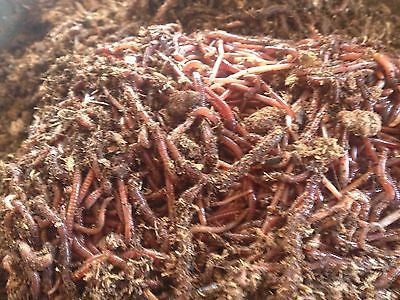Red Wiggler Worms - Efficient Decomposers for Your Compost Container
Red Wiggler Worms - Efficient Decomposers for Your Compost Container
Blog Article
Optimizing the Advantages of Red Wiggler Worms: A Comprehensive Manual for Home Gardeners and Urban Farmers
In the realm of lasting horticulture methods, red wiggler worms stand as unrecognized heroes, silently transforming natural waste into nutrient-rich spreadings that can work marvels for soil health. By discovering the ins and outs of just how to efficiently care for and make the most of the benefits of red wiggler worms, individuals can unlock a riches of possibilities for enhancing the sustainability and performance of their gardening endeavors.
Comprehending Red Wiggler Worms
Red Wiggler worms, renowned for their reliable composting capabilities, are a varieties of earthworms extensively used in vermiculture techniques. These worms, clinically recognized as Eisenia fetida, thrive in decomposing natural material, making them ideal candidates for composting.
One secret quality of Red Wiggler worms is their reproductive rate. These hermaphroditic animals possess both male and female reproductive organs, enabling them to duplicate swiftly under positive conditions. A fully grown Red Wiggler can create numerous children in a brief period, making certain a steady population within a composting system.

Setting Up a Worm Bin
When developing a worm container for vermiculture purposes, correct preparation and interest to information are essential for producing a helpful setting for Red Wiggler worms. Begin by picking an ideal container for your worm bin.

Place the worm container in a great, dark place away from direct sunlight and severe temperatures. By following these actions, you can set up a growing worm container that will efficiently refine organic waste right into nutrient-rich vermicompost for your garden.
Feeding and Maintaining Worms
Making sure a nutritious and balanced diet plan is essential for the health and wellness and productivity of Red Wiggler worms in a vermiculture system. It is important to stay clear of feeding them citrus fruits, onions, garlic, milk products, meat, and oily foods as these can be unsafe to the worms or trigger undesirable odors in the bin.
Appropriate wetness degrees are also important for the wellness of Red Wiggler worms. The bed linens must really feel like a moist sponge, giving adequate dampness for the worms to breathe through their skin. Frequently check the moisture levels and adjust by adding water or completely dry bed linens material as required. In addition, preserving appropriate temperature level problems between 55-77 ° F(13-25 ° C )will make certain ideal worm task and recreation. By faithfully checking their diet, wetness, and environmental conditions, home garden enthusiasts and city farmers can sustain a efficient and healthy Red Wiggler worm population for composting objectives.
Gathering Worm Castings
To efficiently extract nutrient-rich worm castings from the vermicompost, a methodical harvesting process is vital for optimizing the composting advantages. Red Wiggler Worms. The primary step in collecting worm spreadings is to encourage the worms to migrate to one side of the container. This can be accomplished by putting fresh food scraps on one side and leaving the opposite uninterrupted for a few days. Once most of worms have relocated to the side with fresh food, the castings can be accumulated from the opposite side.
After the castings have actually been harvested, it is vital to divide any remaining worms from the castings to prevent hurting them throughout storage or application. One reliable approach is to produce conical heaps of castings under intense light. Worms will naturally move away from the light, enabling very easy separation and removal.
Last but not least, the harvested worm Check Out Your URL castings must be stored in an awesome, dark, and completely dry place to maintain their high quality and efficiency as a nutrient-rich soil modification. By following these steps, home gardeners and city farmers can maximize the advantages of red wiggler worms in their vermicomposting systems.
Utilizing Worm Castings in Gardening
The consolidation of nutrient-rich worm castings right into garden dirt can dramatically enhance plant development and overall soil health. Worm castings, also understood as vermicast, are a natural fertilizer produced by red wiggler worms as they break down raw material. These spreadings are abundant in important Related Site nutrients like nitrogen, phosphorus, potassium, and valuable microorganisms that promote plant growth and enhance soil framework.
When making use of worm castings in horticulture, it is important to mix them completely right into the dirt or utilize them as a top clothing around plants. The slow-release nature of worm spreadings guarantees a stable supply of nutrients to plants with time, minimizing the risk of nutrient leaching and promoting lasting soil fertility. In addition, worm castings aid enhance dirt aeration, water retention, and microbial task, producing a healthy setting for plant origins to thrive.

Verdict
In verdict, the use of red wiggler worms in home horticulture and city farming can substantially profit dirt wellness and plant growth. By recognizing just how to establish up and preserve a worm bin, feed the worms properly, and gather their nutrient-rich spreadings, garden enthusiasts can take visit full advantage of the benefits of these earthworms.
In the world of lasting gardening practices, red wiggler worms stand as unsung heroes, silently changing organic waste into nutrient-rich castings that can function wonders for dirt health and wellness.When establishing a worm container for vermiculture purposes, appropriate prep work and focus to information are crucial for developing a helpful atmosphere for Red Wiggler worms. The very first step in gathering worm spreadings is to motivate the worms to migrate to one side of the bin. Worm spreadings, also recognized as vermicast, are an all-natural fertilizer generated by red wiggler worms as they damage down natural issue. By understanding just how to set up and maintain a worm container, feed the worms correctly, and collect their nutrient-rich castings, gardeners can make the most of the advantages of these earthworms.
Report this page